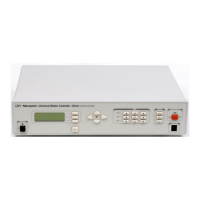• Large velocity ripples, especially at low speeds, causing noise and
possible resonances
• Load torque must be significantly lower than the motor holding
torque to prevent stalling and missing steps
• Limited high speed
5.6.2 DC Motors
A DC motor is similar to a permanent magnet stepper motor with an
added internal phase commutator (
Figure 5.43).
• For a constant load, the velocity is approximately proportional to
the voltage applied to the motor
N
S
ABCDE
Figure 5.43: DC Motor
Applying current to phase B pulls in the rotor pole. If, as soon as the
pole gets there, the current is switched to the next phase C, the rotor
will not stop but continue moving to the next target.
Repeating the current switching process will keep the motor moving
continuously. The only way to stop a DC motor is not to apply any
current to its windings. Due to the permanent magnets, reversing the
current polarity will cause the motor to move in the opposite
direction.
Of course, there is a lot more to the DC motor theory but this
description gives the user a general idea on how they work.
A few other characteristics to keep in mind are:
• For accurate positioning, DC motors need a position feed-back
device.
• Constant current generates approximately constant torque
• If DC motors are tuned externally (manually, etc.) they act as
generators.
Advantages
DC motors are preferred in many applications for the following
reasons:
• Smooth, ripple-free motion at any speed
• High torque per volume
• No risk of loosing position (in a closed loop)
• Higher power efficiency than stepper motors
• No current requirement at stop
• Higher speeds can be obtained than with other types of motors.
5-32 Section 5 – Motion Control Tutorial

